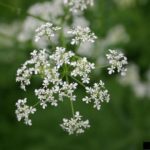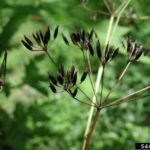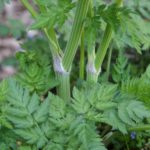Gallery:
- Wild chervil
- Wild chervil invasion
- Wild chervil leaves
- Wild chervil flower cluster
- Wild chervil seed pods
- Wild chervil ridged stems
Common names:
wild chervil, cow parsley, wild beaked parsley, keck, bur chervil
Scientific Name:
Anthriscus sylvestris
Description:
Wild chervil is an herbaceous biennial or short lived perennial in the Apiaceae (carrot) family. It is upright and grows aggressively, so it can shade out native plants. It grows from a taproot and the stems are hollow, ridged, and hairy on the lower portions. The leaves are alternate, very finely divided, fern-like, and slightly hairy. The flowers are small and white with 5 petals, and they grow in umbels (umbrella shape) that can be about 3 inches wide. It spreads by seeds that are transported by wind, animals, people, and vehicles.
Life cycle:
Biennial or short-lived perennial
Height of mature plants
1 to 4 feet
Flower color:
White
Bloom time:
April – June
Look-a-likes:
Wild chervil looks quite similar to wild carrot and poison hemlock as all three plants have fernlike leaves, a taproot and white umbel flowers. A distinguishing feature of wild chervil is the presence of ridges on the stems. Compared to poison hemlock, it is smaller and lacks the odor.
Habitat:
Wild chervil grows in open sunny areas including agricultural areas, open disturbed areas, roadsides, pastures, and yards. It can tolerate many soil types and low to high light intensities.
Impacts:
Wild chervil grows fast and is large, so it out-competes other plants for sunlight and other resources. It creates monocultures that threaten native plants, crops, and agriculture.
Noxious Weed Listing:
- WeedWise: Maintenance
- State of Oregon: Not Listed
- State of Washington: Class B
- Four County CWMA: Class Not Listed
- Columbia Gorge CWMA: Class B
Origin:
Europe
Links:
Washington Noxious Weed Profile
Thurston County profile
Invasive.org Profile






